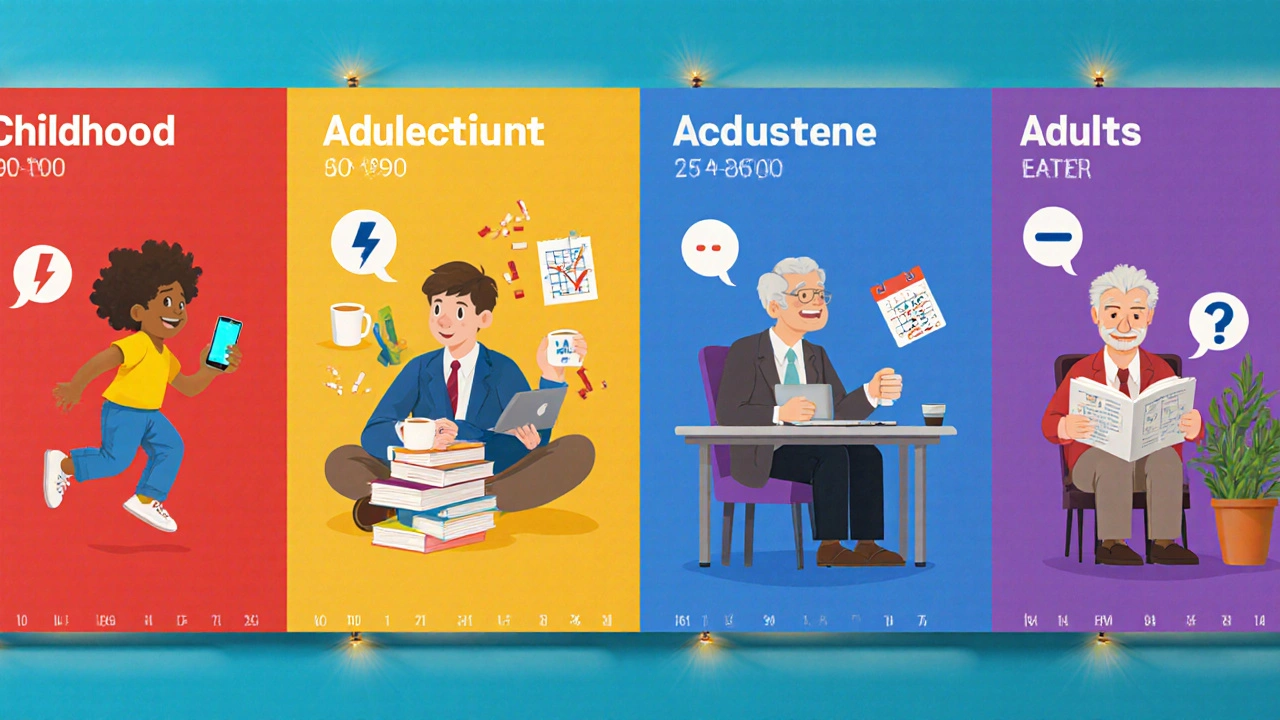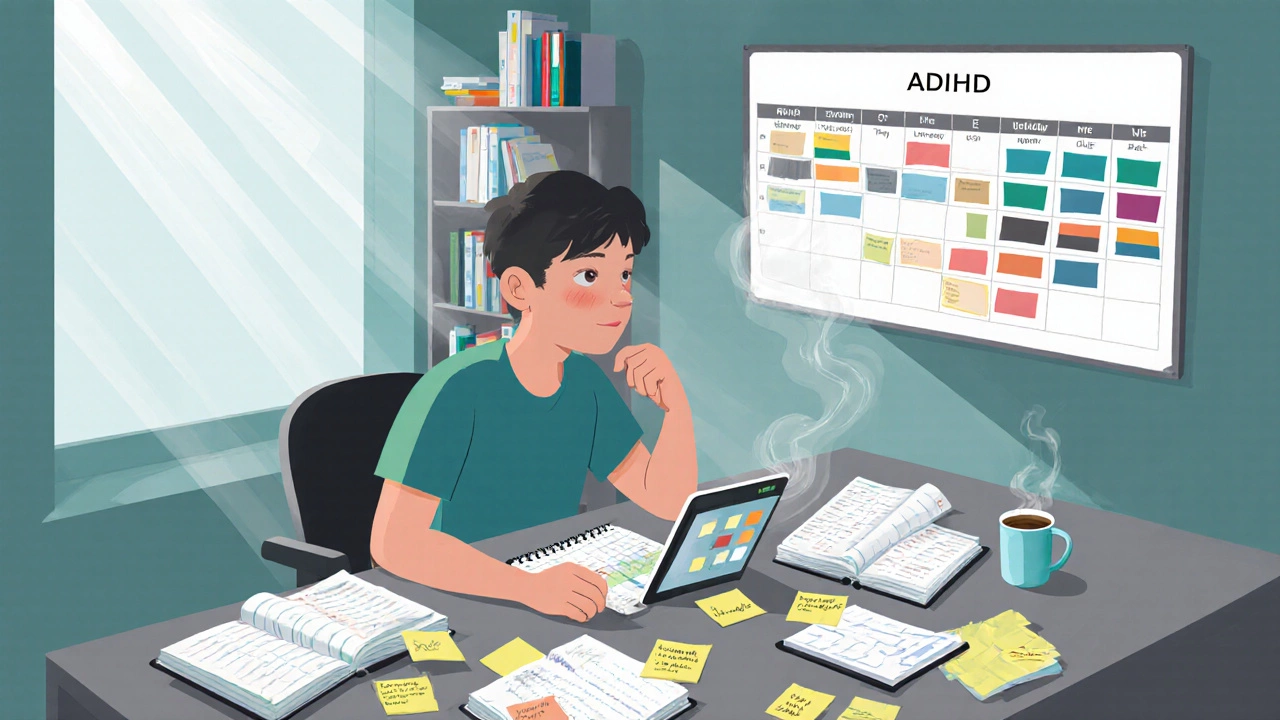
ADHD Symptom Tracker Across Ages
Explore how ADHD symptoms typically evolve across different life stages. Hover over cards to see details.
Childhood (6-12 years)
Hyperactivity: High
Inattention: Moderate
Impulsivity: High
Adolescence (13-19 years)
Hyperactivity: Medium-Low
Inattention: High
Impulsivity: Medium
Adulthood (20-45 years)
Hyperactivity: Low
Inattention: High-Medium
Impulsivity: Low-Medium
Later Life (46+ years)
Hyperactivity: Very Low
Inattention: Medium
Impulsivity: Low
Understanding the Pattern
As individuals age, hyperactivity typically decreases significantly, while inattention and executive function challenges often persist or become more apparent due to increased environmental demands.
Impulsivity generally diminishes but may still surface under stress. Comorbid conditions like anxiety and depression can also influence how symptoms appear in later years.
Symptom Management Tips by Age
- Childhood Medication, behavioral therapy, school accommodations
- Adolescence Medication review, CBT, digital tools
- Adulthood Executive-function coaching, lifestyle changes, comorbidity treatment
- Later Life Medication safety, brain-health activities, routine reinforcement
Quick Take
- ADHD is a lifelong condition; its core traits don’t magically disappear.
- Hyperactivity usually eases, while inattention and executive‑function challenges often become more noticeable.
- Comorbid issues like anxiety, sleep problems, and stress can make ADHD feel worse as you get older.
- Effective management-medication, therapy, lifestyle tweaks-can keep symptoms stable or improve them.
- Regular check‑ins with a clinician are key, especially during major life transitions.
People with ADHD often wonder if the condition gets worse as they age. The short answer: the brain doesn’t suddenly deteriorate, but the way ADHD shows up can shift. In childhood, the loudest flag is usually extra energy; in adulthood, it’s more likely to be trouble staying organized, missing deadlines, or feeling mentally exhausted. Below we break down what science says, why symptoms can feel amplified, and what you can do to stay on top of the condition at any age.
What Exactly Is ADHD?
Attention‑Deficit/Hyperactivity Disorder (ADHD) is a neurodevelopmental condition characterized by persistent patterns of inattention, hyperactivity, and impulsivity that interfere with daily functioning. It affects roughly 5‑7% of children worldwide and about 2‑3% of adults. The diagnosis hinges on symptom count, duration (at least six months), and impact on multiple life areas such as school, work, or relationships.
How ADHD Changes Across the Life Span
Researchers track three broad trajectories:
- Childhood (6‑12years): Hyperactive‑impulsive behavior dominates. Kids might be the kid who can’t sit still, talks constantly, and forgets to bring homework home.
- Adolescence (13‑19years): Hyperactivity often tapers, but inattention, impulsive decision‑making, and emotional dysregulation rise. Academic pressures and social dynamics amplify challenges.
- Adulthood (20+years): The core deficits shift toward executive‑function impairments: time‑management, planning, sustained attention, and emotional regulation.
The brain’s maturation plays a big role. During the teen years, the prefrontal cortex-responsible for planning and impulse control-continues to develop. For people with ADHD, this area often lags behind peers, making executive‑function lapses more obvious.
Why Symptoms May Feel Worse With Age
It’s not that ADHD itself worsens; it’s that the environment becomes more demanding. Several factors can make the condition feel heavier as you get older:
- Comorbidity (the simultaneous presence of two or more disorders) such as anxiety, depression, or substance‑use disorders often emerge in teens and adults, adding extra stress.
- Stress (physiological and psychological response to perceived challenges) from work, finances, or family obligations taxes the brain’s limited attention resources.
- Sleep disturbances (difficulty falling or staying asleep, leading to poor sleep quality) are common in ADHD and become more disruptive when you have a packed schedule.
- Hormonal shifts-especially during puberty and menopause-can affect neurotransmitter balance, influencing focus and mood.
- Medication tolerance or “breakthrough” symptoms can arise if a dosage isn’t adjusted for changing body weight or metabolic rate.
All these layers can create the impression that ADHD is getting worse, even if the underlying neurobiology stays relatively stable.

Managing ADHD From Childhood to Senior Years
Effective management is a blend of pharmacology, therapy, and lifestyle tweaks. Below is a roadmap for each life stage.
Children
- Medication: Stimulants (e.g., methylphenidate, amphetamines) are first‑line. They boost dopamine and norepinephrine, improving focus.
- Behavioral therapy: Parent‑training programs teach consistent routines, positive reinforcement, and clear expectations.
- School support: 504 plans or Individualized Education Programs (IEPs) can provide extra time on tests, preferential seating, or note‑taking assistance.
Adolescents
- Medication review: Doses may need adjustment as body size changes; non‑stimulant options (e.g., atomoxetine) become viable if side‑effects emerge.
- Cognitive‑behavioral therapy (CBT) (a structured, time‑limited psychotherapy focusing on thoughts, feelings, and behaviors) helps with organization, time‑management, and coping with anxiety.
- Digital tools: Apps for task‑tracking and reminders can compensate for working‑memory lapses.
Adults
- Medication continuity: Many adults stay on low‑dose stimulants; some switch to extended‑release formulations to reduce peaks and crashes.
- Executive‑function coaching: Professionals help set up workflows, calendar systems, and accountability structures.
- Lifestyle pillars: Regular aerobic exercise, balanced nutrition, and consistent sleep hygiene have measurable benefits for dopamine regulation.
- Address comorbidities: Treating anxiety or depression can dramatically improve overall functioning.
Later Life (50+years)
- Medication safety: Cardiovascular health becomes a bigger concern; clinicians may favor non‑stimulant options or lower doses.
- Brain‑health activities: Learning new skills, socially engaging, and puzzle‑solving help preserve cognitive reserve.
- Routine reinforcement: Simple, repeatable daily schedules reduce the mental load of planning.
What the Research Says About ADHD symptoms over time
A 2023 longitudinal study of 1,200 participants followed from age 7 to 45 found:
| Age Group | Hyperactivity | Inattention | Impulsivity |
|---|---|---|---|
| Children (6‑12) | High | Moderate | High |
| Adolescents (13‑19) | Medium‑Low | High | Medium |
| Adults (20‑45) | Low | High‑Medium | Low‑Medium |
| Older Adults (46+) | Very Low | Medium | Low |
The pattern shows hyperactivity drops sharply, while inattention tends to stay moderate‑to‑high well into adulthood. Impulsivity follows a middle path, often diminishing but still present in high‑stress situations.
Common Myths About ADHD and Aging
- Myth: “ADHD disappears after puberty.” Fact: Only about 10% of children outgrow clinically significant symptoms; most continue to need support.
- Myth: “Adults can just will themselves to focus.” Fact: Focus is a neurochemical process; intentional effort alone rarely overcomes the dopamine deficit.
- Myth: “Medication is a childhood fix.” Fact: Over 60% of adults with ADHD report that medication remains the most effective single intervention.
When Should You Seek Professional Help?
If you notice any of the following, it’s time to talk to a clinician:
- Persistent trouble meeting work deadlines despite using tools and strategies.
- Increasing anxiety, depression, or substance‑use as coping mechanisms.
- Frequent relationship conflicts rooted in forgetfulness or impulsive remarks.
- Significant sleep problems that affect daytime alertness.
- Any new safety concerns, such as risky driving or financial mismanagement.
A qualified psychiatrist, psychologist, or ADHD‑trained primary‑care doctor can run a thorough assessment and tailor a treatment plan.
Key Takeaways
- ADHD does not magically get worse; its expression evolves.
- Hyperactivity fades, while inattention and executive‑function challenges often become more prominent.
- Comorbidities, stress, and lifestyle factors heavily influence perceived severity.
- Ongoing, age‑appropriate management can keep symptoms stable or improve quality of life.

Frequently Asked Questions
Can ADHD be cured as you get older?
There’s no cure, but symptoms can be managed effectively with medication, therapy, and lifestyle changes. Many adults see a reduction in the most disruptive behaviors.
Why do adults with ADHD feel more disorganized than kids?
Adults face higher demands-multiple projects, finances, family coordination-so the same level of executive‑function deficit feels more crippling. Without external structures (like school schedules), the brain’s wiring shows up as disorganization.
Is medication still safe after 50?
Yes, but doctors often choose lower doses or non‑stimulant options to protect heart health. Regular cardiovascular checks become a part of the monitoring plan.
Do women experience ADHD differently as they age?
Women are more likely to present with inattentive symptoms and internalized anxiety. Hormonal changes around menstruation, pregnancy, and menopause can intensify focus problems, making age‑related shifts more noticeable.
What non‑medication strategies work best for adults?
Executive‑function coaching, CBT, structured routines, regular aerobic exercise, and digital task‑management tools all have strong evidence for reducing daily impairment.





Rohan Talvani
I am a manufacturing expert with over 15 years of experience in streamlining production processes and enhancing operational efficiency. My work often takes me into the technical nitty-gritty of production, but I have a keen interest in writing about medicine in India—an intersection of tradition and modern practices that captivates me. I strive to incorporate innovative approaches in everything I do, whether in my professional role or as an author. My passion for writing about health topics stems from a strong belief in knowledge sharing and its potential to bring about positive changes.
view all postsWrite a comment